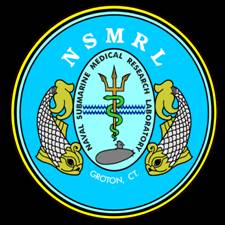 W
WThe Naval Submarine Medical Research Laboratory (NSMRL) is located on the New London Submarine Base in Groton, Connecticut. The laboratory's mission is to protect the health of American sailors, focused on submarines and scuba diving. It is a subordinate command of the Naval Medical Research Center.
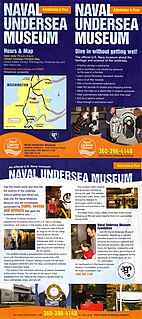 W
WThe United States Naval Undersea Museum is a naval museum located at Keyport, Washington. It is one of the 10 Navy museums that are operated by the Naval History & Heritage Command. It sits next to a branch of the Naval Undersea Warfare Center.
 W
WThe United States Navy Submarine Force Library and Museum is located on the Thames River in Groton, Connecticut. It is the only submarine museum managed exclusively by the Naval History & Heritage Command division of the Navy, and this makes it a repository for many special submarine items of national significance, including USS Nautilus (SSN-571). Visitors may take a 30-minute self-guided audio tour of the Nautilus.
 W
W41 for Freedom refers to the US Navy Fleet Ballistic Missile (FBM) submarines from the George Washington, Ethan Allen, Lafayette, James Madison, and Benjamin Franklin classes. All of these submarines were commissioned 1959-1967, as the goal was to create a credible, survivable sea-based deterrent as quickly as possible. These submarines were nicknamed "41 for Freedom" once the goal of 41 nuclear-powered ballistic missile submarines (SSBNs) was established in the early 1960s. The 1972 SALT I Treaty limited the number of American submarine-launched ballistic missile tubes to 656, based on the total missile tubes of the forty-one submarines, in line with the treaty's goal of limiting strategic nuclear weapons to the number already existing.
 W
WThe Advanced SEAL Delivery System (ASDS) was a midget submarine operated by the United States Navy and United States Special Operations Command. It provided stealthy submerged transportation for United States Navy SEALs from the decks of nuclear submarines for use as an insertion platform for covert and clandestine special operations missions. The ASDS was canceled in 2009 due to cost overruns and reliability issues, after the prototype was destroyed in a fire in 2008. As of 2019, the Navy plans to replace the ASDS with the Dry Combat Submersible, a similar midget submarine being developed by Lockheed Martin.
 W
WUSS Albacore (AGSS-569) is a unique research submarine that pioneered the American version of the teardrop hull form of modern submarines. The revolutionary design was derived from extensive hydrodynamic and wind tunnel testing, with an emphasis on underwater speed and maneuverability. She was the third ship of the United States Navy to be named for the albacore.
 W
WUSS Alligator, the fourth United States Navy ship of that name, is the first known U.S. Navy submarine, and was active during the American Civil War. During the Civil War the Confederate States Navy would also build their own submarine, H. L. Hunley.
 W
WArizona (SSN-803), a Block 5 Virginia-class submarine, will be the fourth United States Navy vessel named for the state of Arizona. Acting Secretary of the Navy Thomas Modly announced the name on 24 December 2019, in a press release. Arizona was authorized for construction on 2 December 2019.
 W
WUSS Arkansas (SSN-800) will be a Block 4 Virginia-class submarine for the United States Navy. It was ordered on April 28, 2014. During a naming ceremony on June 15, 2016, Secretary of the Navy Ray Mabus announced that future U.S. Navy submarine SSN-800 will bear the name USS Arkansas.
 W
WBarb (SSN-804) will be a Block 5 Virginia-class submarine with third United States Navy vessel named for the barb fish. The submarine will also be the first Virginia-class submarine to be named after a aquatic animal and the first U.S. Navy submarine to be named after a aquatic animal following the USS Seawolf (SSN-21), in more than 20 years. Secretary of the Navy Kenneth Braithwaite officially announced the name on October 13, 2020, in a ceremony unveiling plans to construct a new National Museum of the United States Navy in Washington, D.C..
 W
WUSS Darter (SS-576), a unique submarine based on the Tang class, but incorporating many improvements, was the second ship of the United States Navy to be named for the darter, a type of small American fresh-water fish.
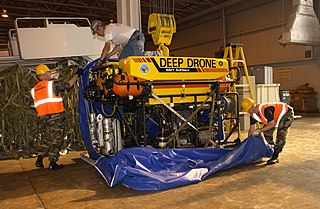 W
WThe Deep Drone is a submersible remotely operated vehicle designed for mid-water salvage for the United States Navy. One vehicle is based in Largo, Maryland, under the command of The U.S. Navy Supervisor of Salvage and Diving (SUPSALV), it is maintained and operated by Phoenix International Inc.. The vehicle is capable of operating at a depth up to 8000 feet as reflected in its full name: "The Deep Drone 8000". The vehicle has a target locating sonar and two tool manipulators capable of working with tools and attaching rigging.
 W
WUSS Dolphin (AGSS-555) was a United States Navy diesel-electric deep-diving research and development submarine. She was commissioned in 1968 and decommissioned in 2007. Her 38-year career was the longest in history for a US Navy submarine. She was the Navy's last operational conventionally powered submarine.
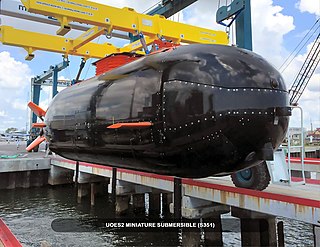 W
WThe Dry Combat Submersible (DCS) is a midget submarine designed and manufactured for USSOCOM by MSubs Ltd, a UK company located in Plymouth, Devon. MSubs are an underwater R&D company that have built a number of specialist unmanned and manned submersibles, primarily for the US DoD. MSubs is wholly owned by Submergence Group LLC, a small Texas based company that provides the linkages into the DOD and is responsible for contract support, most notably operator training. Due to the nature of the contract Lockheed Martin were nominated as the prime contractor with Submergence Group as the sub contractor. With the exception of a limited amount of Government Furnished Equipment (GFE), manufacture, assembly and initial sea trials all take place in the UK. DCS is designed for use by the United States Navy SEALs for insertion on special operations missions. It will replace the canceled Advanced SEAL Delivery System and will serve alongside the Shallow Water Combat Submersible. As the name suggests, the Dry Combat Submersible has a dry interior, enabling longer mission durations in colder water. The DCS is designated the S351 Nemesis.
 W
WDSV-5, ex-NEMO, was a submersible used by the United States Navy between 1970 and 1986 to oversee and observe undersea construction work. NEMO had a spherical transparent acrylic hull, which gave occupants panoramic vision. NEMO was the first submersible with a hull made entirely out of transparent acrylic (Plexiglass), and much of her career was spent testing this hull design. NEMO was found to be an effective observation platform, despite not being able to hover in place, and acrylic-hulled submersibles have continued to be built and operated in the United States. NEMO is considered part of the Alvin class of Deep Submergence Vehicles despite bearing little resemblance to the other subs of the class. NEMO was transferred to "other government agencies" in 1986 and retired from government service in 2011. It was then given to the U.S. Navy Seabee Museum, where it remains on display.
 W
WCaptain John Henry Ebersole, M.D., MC USN a pioneer in submarine medicine and radiation oncology, selected by Admiral Hyman G. Rickover to serve as medical officer aboard the US Navy's first two nuclear powered submarines, the USS Nautilus and the USS Seawolf. He was the radiologist for NASA that screened the Mercury Seven astronauts for Project Mercury. Ebersole was the radiologist responsible for the x-rays taken during the autopsy of John F. Kennedy on 22 November 1963 at Bethesda Naval Medical Center.
 W
WUSS Glenard P. Lipscomb (SSN-685) was a nuclear-powered attack submarine of the United States Navy.
 W
WThe Greater Underwater Propulsion Power Program (GUPPY) was initiated by the United States Navy after World War II to improve the submerged speed, maneuverability, and endurance of its submarines.
 W
WUSS Halibut (SSGN-587), a unique nuclear-powered guided missile submarine-turned-special operations platform, later redesignated as an attack submarine SSN-587, was the second ship of the United States Navy to be named after the halibut.
 W
WUSS Holland (SS-1) was the United States Navy's first modern commissioned submarine, although not the first military submarine of the United States, which was the 1775 submersible Turtle. The boat was originally laid down as Holland VI at the Crescent Shipyard of Elizabeth, New Jersey for John Holland's Holland Torpedo Boat Company, and launched on 17 May 1897. She was acquired by the USN on 11 April 1900 and commissioned on 12 October 1900, Lieutenant H. H. Caldwell commanding.
 W
WIdaho (SSN-799), a Virginia-class submarine, will be the fifth U.S. Navy vessel named for the state of Idaho. Secretary of the Navy Ray Mabus announced the name on August 23, 2015, at a ceremony in Idaho.
 W
WIowa (SSN-797), a Virginia-class submarine, will be the fourth U.S. Navy vessel named for the state of Iowa. Secretary of the Navy Ray Mabus officially announced the name on September 2, 2015, during a news briefing at Iowa State University.
 W
WUSS M-1 (SS-47) was a unique submarine of the United States Navy. M-1 was designed as a test bed for the newest technology in submarine construction and design. As well as being the world's first double-hulled design, her battery was of a new design and was to have solved some of the past flaws. While no other M-class submarines were built, the lessons learned were incorporated into the following AA-1 class.
 W
WUSS Massachusetts (SSN-798), a Virginia-class submarine, will be the seventh U.S. Navy vessel named for the state of Massachusetts. Secretary of the Navy Ray Mabus announced the name on November 8, 2015 in an opinion piece for The Boston Globe. She is the first vessel named after the Commonwealth of Massachusetts since the now-preserved battleship USS Massachusetts (BB-59) was decommissioned in 1947.
 W
WUSS Narwhal (SSN-671), a unique submarine, was the third ship of the United States Navy to be named for the narwhal, a gray and white arctic whale with a unicorn-like, ivory tusk.
 W
WUSS Nautilus (SSN-571) was the world's first operational nuclear-powered submarine and the first submarine to complete a submerged transit of the North Pole on 3 August 1958. Her initial commanding officer was Eugene Parks "Dennis" Wilkinson, a widely respected naval officer who set the stage for many of the protocols of today's Nuclear Navy, and who had a storied career during military service and afterwards.
 W
WNew Jersey (SSN-796), a Virginia-class submarine, will be the third U.S. Navy vessel named for the state of New Jersey. Secretary of the Navy Ray Mabus announced the name on May 24, 2015, at a ceremony in Jersey City, New Jersey.
 W
WDeep Submergence Vessel NR-1 was a unique United States Navy (USN) nuclear-powered ocean engineering and research submarine, built by the Electric Boat Division of General Dynamics at Groton, Connecticut. NR-1 was launched on 25 January 1969, completed initial sea trials 19 August 1969, and was home-ported at Naval Submarine Base New London. NR-1 was the smallest nuclear submarine ever put into operation. The vessel was casually known as "Nerwin" and was never officially named or commissioned. The U.S. Navy is allocated a specific number of warships by the U.S. Congress. Admiral Hyman Rickover avoided using one of those allocations, and he also wanted to avoid the oversight that a warship receives from various bureaus.
 W
WOklahoma (SSN-802), a Block 5 Virginia-class submarine, will be the second United States Navy vessel named for the state of Oklahoma. Acting Secretary of the Navy Thomas Modly announced the name on 24 December 2019, in a press release. Oklahoma was authorized for construction on 2 December 2019.
 W
WPlunger was one of the first submarines built for the United States Navy. She was ordered in 1895 and launched in 1897, but was never commissioned.
 W
WThe Regulus missile submarines were a group of submarines operated by the United States Navy capable of carrying the Regulus cruise missile. Between 1959 and 1964, a total of five boats were used to undertake the first submarine-based nuclear deterrent patrols by the United States. Regulus submarines were used for this task until 1964, when sufficient ballistic missile submarines carrying the Polaris ballistic missile became available.
 W
WThe SEAL Delivery Vehicle (SDV) is a manned submersible and a type of swimmer delivery vehicle used to deliver United States Navy SEALs and their equipment for special operations missions. It is also operated by the Royal Navy's Special Boat Service, which operates 3 SDVs.
 W
WUSS Seawolf (SSN-575), a unique submarine, was the third ship of the United States Navy to be named for the seawolf, the second nuclear submarine, and the only US submarine built with a liquid metal cooled (sodium) nuclear reactor known as the Submarine Intermediate Reactor (SIR) or Liquid Metal Fast Reactor (LMFR), later designated S2G. Her overall design was a variant of Nautilus, but with numerous detail changes, such as a conning tower, stepped sail, and the BQR-4 passive sonar mounted in the top portion of the bow instead of further below. This sonar arrangement resulted in an unusual bow shape above the water for a U.S. submarine. Her distinctive reactor was later replaced with a standard pressurized water reactor, the replacement process lasting from 12 December 1958 to 30 September 1960.
 W
WThe Shallow Water Combat Submersible (SWCS) is a manned submersible and a type of swimmer delivery vehicle that is planned to be used to deliver United States Navy SEALs and their equipment for special operations missions. It will replace the current Mark 8 SEAL Delivery Vehicle. The Navy planned to introduce the SWCS in 2018, although "slippage in the development" has delayed its introduction until 2019. As of October 2018, two subs have been delivered to the Navy while another two were in production. The SWCS will serve alongside the Dry Combat Submersible (DCS), a midget submarine with a dry interior being developed by Lockheed Martin as a replacement for the cancelled Advanced SEAL Delivery System (ASDS).
 W
WUSS Sailfish (SS-192), was a US Sargo-class submarine, originally named Squalus. As the Squalus, the submarine sank off the coast of New Hampshire during test dives on 23 May 1939. The sinking drowned 26 crew members, but an ensuing rescue operation using the McCann Rescue Chamber saved the lives of the remaining 33 aboard. The submarine was salvaged in late 1939 and decommissioned.
 W
WTrieste is a Swiss-designed, Italian-built deep-diving research bathyscaphe which reached a record depth of about 10,911 metres (35,797 ft) in the Challenger Deep of the Mariana Trench near Guam in the Pacific. On 23 January 1960, Jacques Piccard and US Navy Lieutenant Don Walsh achieved the goal of Project Nekton. It was the first manned vessel to reach the bottom of the Challenger Deep.
 W
WTrieste II (DSV-1) was the successor to Trieste—the United States Navy's first bathyscaphe purchased from its Swiss designers. The original Trieste design was heavily modified by the Naval Electronics Laboratory in San Diego, California and built at the Mare Island Naval Shipyard. Trieste II incorporated the original Terni, Italian-built sphere used in Trieste, after it was made redundant by the new high-pressure sphere cast by the German Krupp Steelworks. The Trieste sphere was suspended from an entirely new float, more seaworthy and streamlined than the original but operating on identical principles. Completed in early 1964, Trieste II was placed on board USNS Francis X. McGraw (T-AK241) and shipped, via the Panama Canal, to Boston.
 W
WUSS Tullibee (SSN-597), a unique submarine, was the second ship of the United States Navy to be named for the tullibee, any of several whitefishes of central and northern North America.
 W
WGerman submarine U-1105, a Type VII-C/41 U-boat of Nazi Germany's Kriegsmarine, was built at the Nordseewerke Shipyard, Emden, Germany, and commissioned on 3 June 1944. Oberleutnant zur See Hans-Joachim Schwarz was given command. He would command U-1105 for the remainder of the war.
 W
WGerman submarine U-2513 was a Type XXI U-boat of Nazi Germany's Kriegsmarine, that was operated by the United States Navy for several years after World War II.
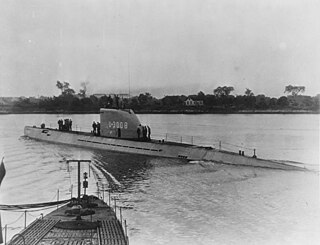 W
WThe German submarine U-3008 was a Type XXI U-boat of Nazi Germany's Kriegsmarine that served in the United States Navy for several years after World War II.
 W
WUtah (SSN-801), a Virginia-class submarine, will be the second U.S. Navy vessel named for the state of Utah. Secretary of the Navy Ray Mabus announced the name on September 28, 2015, at a ceremony in Salt Lake City, Utah.
 W
WThe Virginia class, also known as the SSN-774 class, is a class of nuclear-powered cruise missile fast-attack submarines, currently in military service in the United States Navy. Designed by General Dynamics's Electric Boat (EB) and Huntington Ingalls Industries, the Virginia-class submarines are the United States Navy's latest undersea warfare platform which incorporates the latest in stealth, intelligence gathering and weapons systems technology.
 W
WX-1 was the United States Navy's only midget submarine, laid down on 8 June 1954, at Deer Park, Long Island, New York, by the Engine Division of Fairchild Engine and Airplane Corporation, launched on 7 September 1955, at Oyster Bay, Long Island, by Jakobson Shipyard; delivered to the Navy on 6 October at New London, Connecticut, and placed in service on 7 October 1955, with Lieutenant Kevin Hanlon in command.